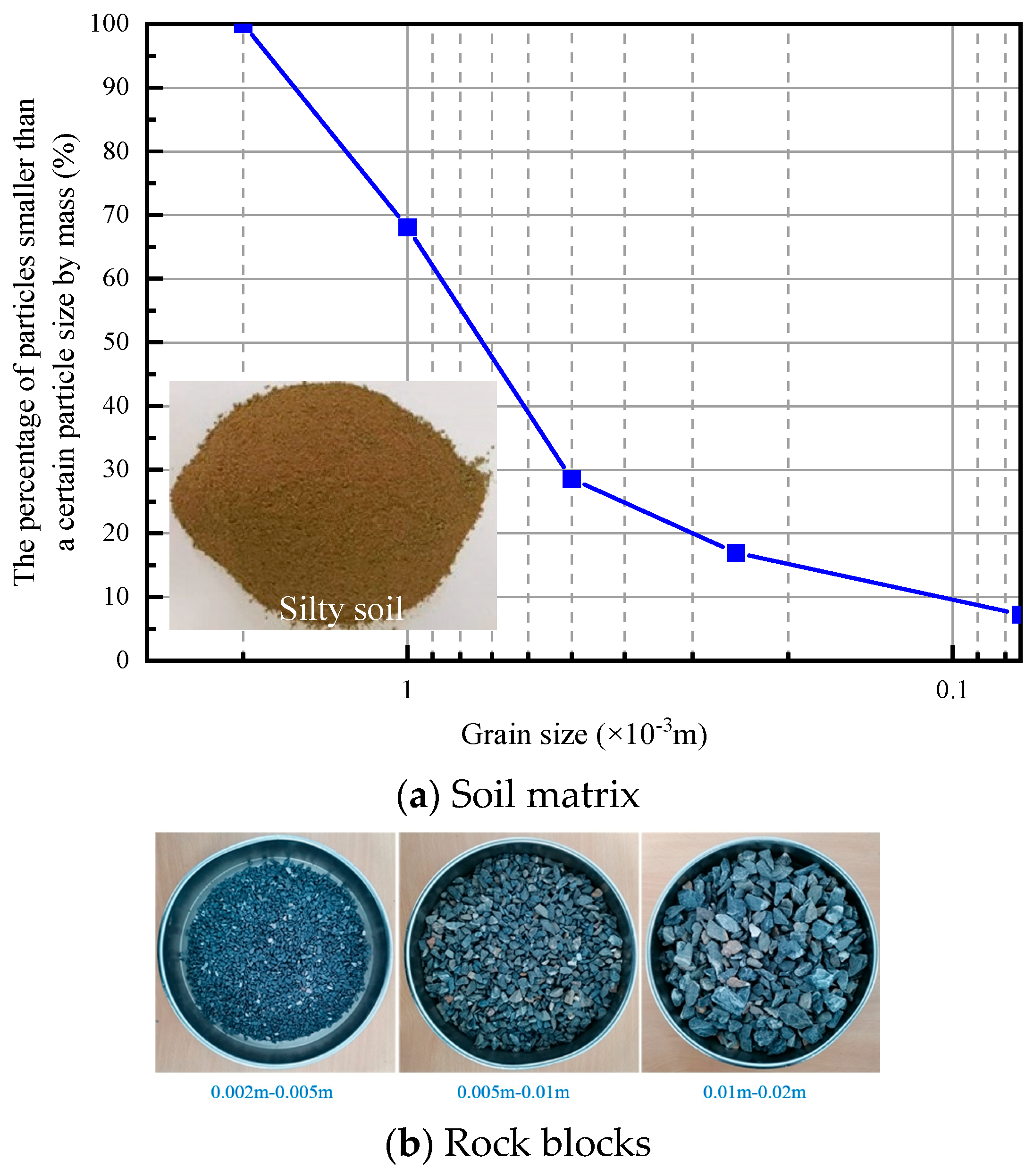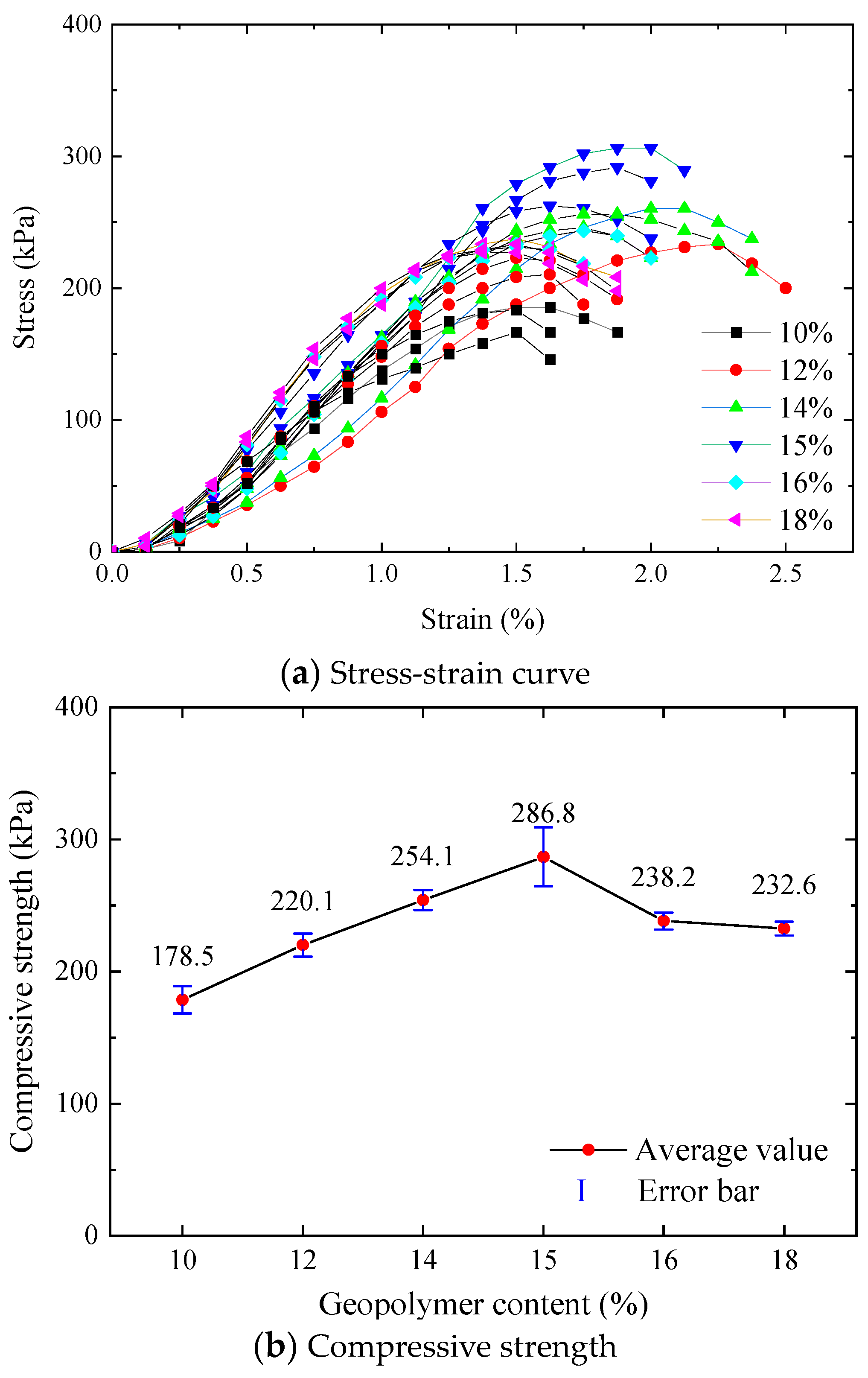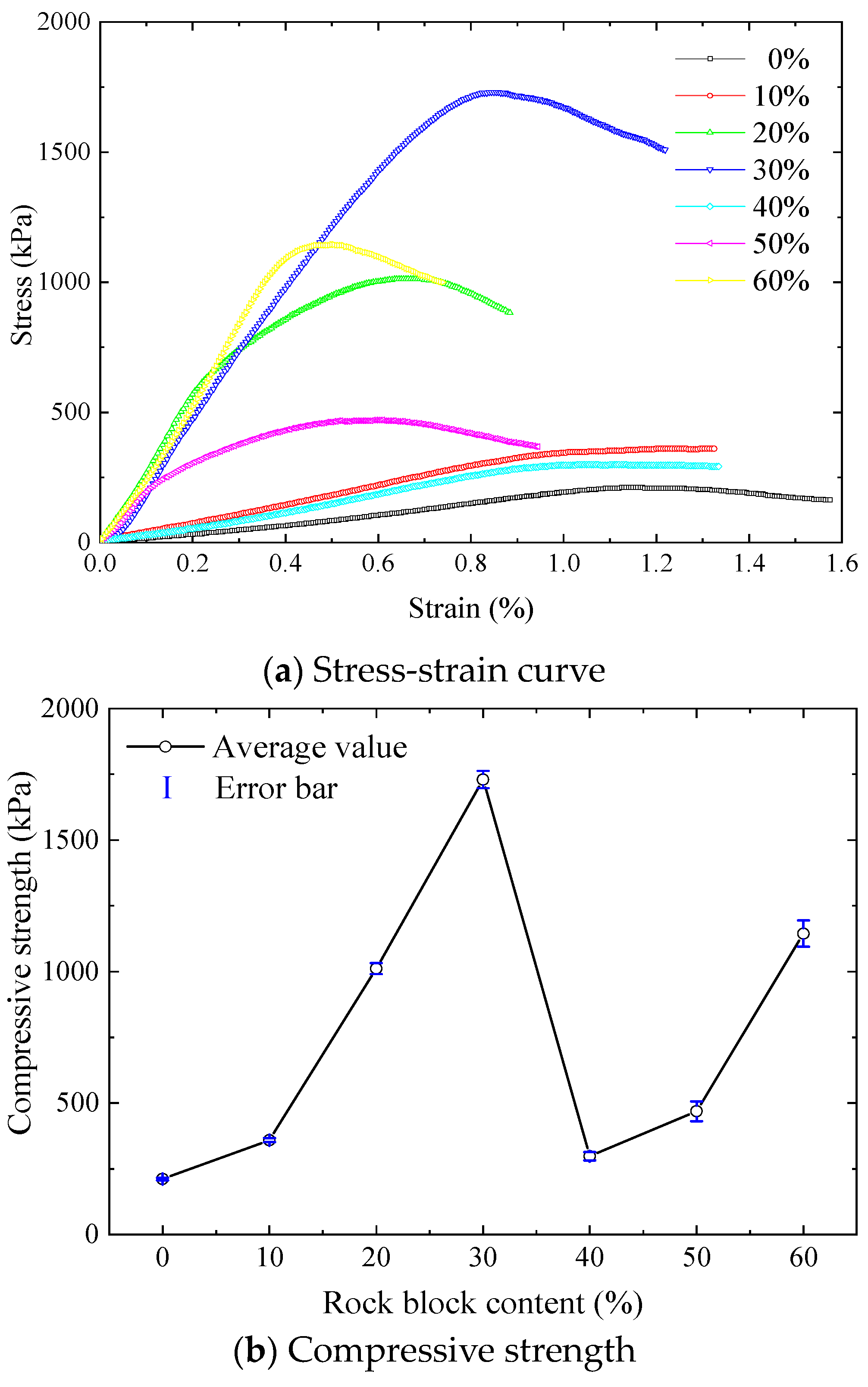Influence of Rock Block Content on Mechanical Properties of Coarse-Grained Fillers Stabilized with Fiber and Geopolymer
Abstract
:1. Introduction
2. Materials and Methods
2.1. Testing Materials
2.2. Testing Equipment
2.3. Testing Scheme
2.4. Specimen Preparation
3. Results and Discussion
3.1. The Optimum Dosage of Geopolymer for Silty Soil Stabilization
3.2. The Optimum Mixing Design of Fiber for Silty Soil Stabilization
3.3. The Influence of Rock Block Content on the Compressive Strength of Coarse-Grained Fillers Stabilized with Fiber and Geopolymer
3.4. The Influence of Rock Block Content on the Elastic Modulus of Coarse-Grained Fillers Stabilized with Fiber and Geopolymer
3.5. The Influence of Rock Block Content on the Failure Characteristics of Coarse-Grained Fillers Stabilized with Fiber and Geopolymer
4. Conclusions
- (1)
- The ideal mass mixing ratio of geopolymer for coarse-grained filler stabilization was 15% of dry fine-grained soil in weight, and the ideal dosage and length of fiber was 0.4% of dry fine-grained soil in weight and 1.2 × 10−2 m.
- (2)
- The compressive strength of coarse-grained filled stabilized with fiber and geopolymer showed a tendency to increase first, then decrease, and then increase again with the increase in rock block content. Their best compressive strength and resistance to deformation were achieved when the rock block content was 30%.
- (3)
- The strength performance of coarse-grained filled stabilized with fiber and geopolymer was mainly affected by the joint action of the soil matrix, rock blocks, and the cementitious interface between them. Their ability to resist deformation was controlled by the synergy of these three.
- (4)
- The initial cracks gradually spread outward along the interfaces between the soil matrix and rock blocks first and then penetrated through the whole specimen. The failure pattern of fiber- and geopolymer-stabilized coarse-grained fillers changed from shearing slip failure to vertical splitting failure with the increase in rock block content.
- (5)
- Although this study investigated the macroscopic mechanical properties of fiber- and geopolymer-stabilized coarse-grained fillers using a series of indoor tests and can provide a reference for their engineering application and broaden the scope of filler demand, their intrinsic enhancement mechanism and destructive mechanism were still not able to be fully disclosed by objective experimental evidence. Further research on fiber- and geopolymer-stabilized coarse-grained fillers considered from a microscopic point of view is very necessary in the future.
Author Contributions
Funding
Data Availability Statement
Acknowledgments
Conflicts of Interest
References
- Editorial Department of China Journal of Highway and Transport. Transport Review on China’s Subgrade Engineering Research 2021. China J. Highw. Transp. 2021, 34, 1–49. [Google Scholar]
- Zhai, W.; Zhao, C.; Xia, H.; Xie, Y.; Li, G.; Cai, C.; Luo, Q.; Song, X. Basic Scientific Issues on Dynamic Performance Evolution of the High-Speed Railway Infrastructure and Its Service Safety. Sci. Sin. Technol. 2014, 44, 645–660. [Google Scholar] [CrossRef]
- Zhang, J.; Ding, L.; Li, F.; Peng, J. Recycled Aggregates from Construction and Demolition Wastes as Alternative Filling Materials for Highway Subgrades in China. J. Clean. Prod. 2020, 255, 120223. [Google Scholar] [CrossRef]
- Leng, W.M.; Zhou, W.Q.; Nie, R.S.; Zhao, C.Y.; Liu, W.J.; Yang, Q. Analysis of Dynamic Characteristics and Accumulative Deformation of Coarse-Grained Soil Filling of Heavy-Haul Railway. Rock Soil Mech. 2016, 36, 640–646. [Google Scholar]
- Liu, X.; Liu, E.; Zhang, D.; Zhang, G.; Yin, X.; Song, B. Study on Effect of Coarse-Grained Content on the Mechanical Properties of Frozen Mixed Soils. Cold Reg. Sci. Technol. 2019, 158, 237–251. [Google Scholar] [CrossRef]
- Bu, J.Q.; Wang, T.L. Influences of Freeze-Thaw and Fines Content on Mechanical Properties of Coarse-Grained Soil. Chin. J. Geotech. Eng. 2015, 37, 608–614. [Google Scholar]
- Cai, L.; Wang, S.; Gao, X.; Li, G. Influence of Rock Block Content on Compaction Characteristics of Graded Coarse-Grained Fillers. Front. Phys. 2021, 9, 782966. [Google Scholar] [CrossRef]
- Wang, S.; Gao, X.; Ma, W.; Zhao, K.; Xu, P. Experimental Study on Static and Dynamic Characteristics of Geopolymer-Stabilized Coarse-Grained Soils|Acta Geotechnica. Acta Geotech. 2024, 19, 717–739. [Google Scholar] [CrossRef]
- Dou, M.J.; Hu, Z.S.; He, Z.W.; Zhang, Y.Q. Distributing Regularities of Subgrade Diseases in Permafrost Section of the Qinghai-Tibetan Highway. J. Glaciolgy Geocryol. 2002, 24, 780–784. [Google Scholar]
- Du, X.Y.; Ye, Y.S.; Zhang, Q.L.; Cheng, A.J. Experimental Research on Frost Heaving Characteristics of Coarse Grained Soil Filler of High Speed Railway Subgrade in Cold Region. In Proceedings of the Proceedings of the 2014 International Conference on Mechanics and Civil Engineering, Wuhan, China, 13–14 December 2014; Atlantis Press: Amsterdam, The Netherlands, 2014; pp. 836–843. [Google Scholar]
- Dasgupta, S. Russia Pushes Beijing-to-Moscow High-Speed-Rail Link. Eng. News-Rec. 2015, 274, 13. [Google Scholar]
- Zhang, D.Q.; Xue, Y.; Luo, Q.; Yang, E.H. Research on the Anti-Frost Subgrade Bed Structure of Moscow-Kazan High-Speed Railway in Russia. J. Railw. Eng. Soc. 2018, 35, 29–33. [Google Scholar]
- Jin, L.; Zeng, Y.-W.; Zhang, S. Large Scale Triaxial Tests on Effects of Rock Block Proportion and Shape on Mechanical Properties of Cemented Soil-Rock Mixture. Rock Soil Mech. 2017, 38, 141–149. [Google Scholar] [CrossRef]
- Wang, T.L.; Liu, J.K.; Peng, L.Y.; Tian, Y.H. Research on the Mechanical Properties of the Cement-Modified Soil under the Action of Freezing and Thawing Cycles. China Railw. Sci. 2010, 31, 7–13. [Google Scholar]
- Wang, S.N.; Shi, C.; Xu, W.Y.; Wang, H.L.; Zhu, Q.Z. Numerical Direct Shear Tests for Outwash Deposits with Random Structure and Composition. Granul. Matter 2014, 16, 771–783. [Google Scholar] [CrossRef]
- Mir, N.; Khan, S.A.; Kul, A.; Sahin, O.; Ozcelikci, E.; Sahmaran, M.; Koc, M. Construction and Demolition Waste-Based Self-Healing Geopolymer Composites for the Built Environment: An Environmental Profile Assessment and Optimization. Constr. Build. Mater. 2023, 369, 130520. [Google Scholar] [CrossRef]
- Alhawat, M.; Ashour, A.; Yildirim, G.; Aldemir, A.; Sahmaran, M. Properties of Geopolymers Sourced from Construction and Demolition Waste: A Review. J. Build. Eng. 2022, 50, 104104. [Google Scholar] [CrossRef]
- Wang, S.N.; Xue, Q.P.; Zhu, Y.; Li, G.Y.; Wu, Z.J.; Zhao, K. Experimental Study on Material Ratio and Strength Performance of Geopolymer-Improved Soil. Constr. Build. Mater. 2021, 267, 120469. [Google Scholar] [CrossRef]
- Hoy, M.; Horpibulsuk, S.; Arulrajah, A. Strength Development of Recycled Asphalt Pavement—Fly Ash Geopolymer as a Road Construction Material. Constr. Build. Mater. 2016, 117, 209–219. [Google Scholar] [CrossRef]
- Yang, Z.J.; He, M.; Wu, Y.; Shi, Y.P.; Sun, L.; Pan, Z.; Zhang, M. Mechanical Properties and Road Performance of Slag-fly Ash Geopolymer Stabilized Sludge. Bull. Chin. Ceram. Soc. 2022, 41, 693–703. [Google Scholar]
- Hu, C.; Shi, C.; Zhang, Y.; Chen, X.; Luo, S. Numerical Simulation Study on Erosion Collapse Failure Mechanism of Cemented Conglomerate Accumulation. Eng. Comput. 2023, 40, 1407–1419. [Google Scholar] [CrossRef]
- Vallejo, L.E.; Mawby, R. Porosity Influence on the Shear Strength of Granular Material–Clay Mixtures. Eng. Geol. 2000, 58, 125–136. [Google Scholar] [CrossRef]
- Irfan, T.Y.; Tang, K.Y. Effect of the Coarse Fractions on the Shear Strength of Colluvium; Geotechnical Engineering Office, Civil Engineering Department: Beijing, China, 1993.
- Shi, C.; Chen, K.; Xu, W.; Zhang, H.; Wang, H.; Wang, S. Construction of a 3D Meso-Structure and Analysis of Mechanical Properties for Deposit Body Medium. J. Cent. South Univ. 2015, 22, 270–279. [Google Scholar] [CrossRef]
- Shi, C.; Shen, J.; Xu, W.; Wang, R.; Wang, W. Micromorphological Characterization and Random Reconstruction of 3D Particles Based on Spherical Harmonic Analysis. J. Cent. South Univ. 2017, 24, 1197–1206. [Google Scholar] [CrossRef]
- Zhang, J.; Li, C.; Ding, L.; Li, J. Performance Evaluation of Cement Stabilized Recycled Mixture with Recycled Concrete Aggregate and Crushed Brick. Constr. Build. Mater. 2021, 296, 123596. [Google Scholar] [CrossRef]
- Kong, X.; Tian, S.; Tang, L.; Ling, X.; Li, S.; Cai, D. Dynamic Behavior of Coarse-Grained Materials with Different Fines Contents after Freeze-Thaw Cycles under Multi-Stage Dynamic Loading: Experimental Study and Empirical Model. Cold Reg. Sci. Technol. 2020, 175, 103078. [Google Scholar] [CrossRef]
- Kuenza, K.; Towhata, I.; Orense, R.P.; Wassan, T.H. Undrained Torsional Shear Tests on Gravelly Soils. Landslides 2004, 1, 185–194. [Google Scholar] [CrossRef]
- Tang, L.; Li, G.; Li, Z.; Jin, L.; Yang, G. Shear Properties and Pore Structure Characteristics of Soil–Rock Mixture under Freeze–Thaw Cycles. Bull. Eng. Geol. Environ. 2021, 80, 3233–3249. [Google Scholar] [CrossRef]
- Wang, X.; Ding, X.L. Numerical Tests on Impact of Stone Content to Mechanical Parameters of Soil-Rock Mixture. Port Waterw. Eng. 2010, 2010, 93–99. [Google Scholar]
- Sonmez, H.; Gokceoglu, C.; Medley, E.W. Estimating the Uniaxial Compressive Strength of a Volcanic Bimrock. Int. J. Rock Mech. Min. Sci. 2006, 43, 554–561. [Google Scholar] [CrossRef]
- Xuan, D.X.; Molenaar, A.A.A.; Houben, L.J.M. Evaluation of Cement Treatment of Reclaimed Construction and Demolition Waste as Road Bases. J. Clean. Prod. 2015, 100, 77–83. [Google Scholar] [CrossRef]
- Zhang, Y.; Shao, J.; Liu, Z.; Shi, C.; De Saxcé, G. Effects of Confining Pressure and Loading Path on Deformation and Strength of Cohesive Granular Materials: A Three-Dimensional DEM Analysis. Acta Geotech. 2019, 14, 443–460. [Google Scholar] [CrossRef]
- Shi, C.; Li, D.; Xu, W.; Wang, R. Discrete Element Cluster Modeling of Complex Mesoscopic Particles for Use with the Particle Flow Code Method. Granul. Matter 2015, 17, 377–387. [Google Scholar] [CrossRef]
- Wang, S.; Xue, Q.; Ma, W.; Zhao, K.; Wu, Z. Experimental Study on Mechanical Properties of Fiber-Reinforced and Geopolymer-Stabilized Clay Soil. Constr. Build. Mater. 2021, 272, 121914. [Google Scholar] [CrossRef]
- Gu, L.; Deng, X.; Zhang, M.; Wang, S.; Li, B.; Ji, J. Stabilization of Fluidic Silty Sands with Cement and Steel Slag. Buildings 2023, 13, 2705. [Google Scholar] [CrossRef]
- Wang, Y.; Li, X.; Li, S.; Li, G.; Zhao, Z. Cracking Deformation Characteristics for Rock and Soil Aggregate under Uniaxial Compressive Test. Chin. J. Rock Mech. Eng. 2015, 34, 3541–3552. [Google Scholar]
- Xu, W.; Hu, R.; Yue, Z. Development of Random Mesostructure Generating System of Soil-Rock Mixture and Study of Its Mesostructural Mechanics Based on Numerical Test. Chin. J. Rock Mech. Eng. 2009, 28, 1652–1665. [Google Scholar]
- Shimamura, A.; Kashiwa, H.; Miyamoto, Y. Study on Earthquake Response Reduction of Direct Foundation Using Composite Geomaterial. In Proceedings of the 15th WCEE 2012, Lisboa, Portugal, 24–28 September 2012; p. 201918383. [Google Scholar]








| Density /(kg/m3) | Liquid Limit /% | Plastic Limit /% | Plasticity Index /% | Optimum Water Content/% | Maximum Dry Density/(kg/m3) |
|---|---|---|---|---|---|
| 2685 | 34 | 18 | 16 | 12 | 1700 |
| Chemical Composition | SiO2 | Al2O3 | Fe2O3 | CaO | MgO | K2O | Na2O | SO3 | TiO2 |
|---|---|---|---|---|---|---|---|---|---|
| Mass ratio/% | 57.16 | 37.71 | 1.28 | 0.13 | 0.09 | 0.55 | 0.01 | 0.01 | 3.06 |
| Diameter /µm | Density /(kg/m3) | Tensile strength/Mpa | Elastic Modulus/Gpa | Ultimate Elongation/% | Acid and Alkali Resistance | Melting Point/°C |
|---|---|---|---|---|---|---|
| 13 | 2650 | ≥2000 | 90~110 | 3.5 | ≥99% | 1250 |
| Steps | The Ratio of Geopolymer (%) | The Ratio of Basalt Fiber (%) | Lengths of Basalt Fiber (m) | Initial Water Content (%) | Curing Temperature (°C) | Curing Age (d) |
|---|---|---|---|---|---|---|
| Ⅰ | 10, 12, 14, 15, 16, 18 | - | - | 14 | 20 | 7 |
| Ⅱ | 15 | 0.2, 0.3, 0.4, 0.5 | 1.2 × 10−2 | 14 | 20 | 7 |
| Ⅲ | 15 | 0.4 | 9 × 10−3, 1.2 × 10−2, 1.5 × 10−2, 1.8 × 10−2 | 14 | 20 | 7 |
| Steps | The Content of Rock Block (%) | The Ratio of Geopolymer (%) | The Ratio of Basalt Fiber (%) | Lengths of Basalt Fiber (m) | Initial Water Content (%) | Curing Temperature (°C) | Curing Age (d) |
|---|---|---|---|---|---|---|---|
| Ⅳ | 0, 10, 20, 30, 40, 50, 60 | 15 | 0.4 | 1.2 × 10−2 | 15 | 20 | 7 |
| Items | The Content of Rock Blocks (%) | The Ratio of Geopolymer (%) | The Ratio of Basalt Fiber (%) | Lengths of Basalt Fiber (m) |
|---|---|---|---|---|
| Values | 30 | 15 | 0.4 | 1.2 × 10−2 |
Disclaimer/Publisher’s Note: The statements, opinions and data contained in all publications are solely those of the individual author(s) and contributor(s) and not of MDPI and/or the editor(s). MDPI and/or the editor(s) disclaim responsibility for any injury to people or property resulting from any ideas, methods, instructions or products referred to in the content. |
© 2024 by the authors. Licensee MDPI, Basel, Switzerland. This article is an open access article distributed under the terms and conditions of the Creative Commons Attribution (CC BY) license (https://creativecommons.org/licenses/by/4.0/).
Share and Cite
Yu, H.; Ji, J.; Gu, L.; Wang, S.; Wu, Z.; Li, M. Influence of Rock Block Content on Mechanical Properties of Coarse-Grained Fillers Stabilized with Fiber and Geopolymer. Buildings 2024, 14, 2404. https://doi.org/10.3390/buildings14082404
Yu H, Ji J, Gu L, Wang S, Wu Z, Li M. Influence of Rock Block Content on Mechanical Properties of Coarse-Grained Fillers Stabilized with Fiber and Geopolymer. Buildings. 2024; 14(8):2404. https://doi.org/10.3390/buildings14082404
Chicago/Turabian StyleYu, Hongli, Jiufa Ji, Leilei Gu, Shengnian Wang, Zhijian Wu, and Mingwei Li. 2024. "Influence of Rock Block Content on Mechanical Properties of Coarse-Grained Fillers Stabilized with Fiber and Geopolymer" Buildings 14, no. 8: 2404. https://doi.org/10.3390/buildings14082404





